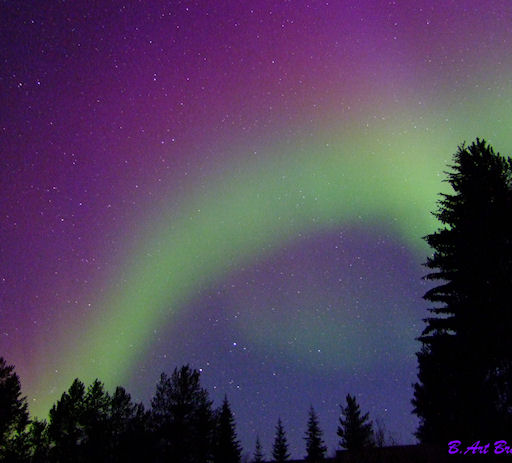Metallic photos of the sun by renowned photographer Greg Piepol bring together the best of art and science. Buy one or a whole set. They make a stellar gift. | | |
MORNING SKY SHOW: Awake at dawn? Rush to the window and look east. For the next two mornings, the crescent Moon and Venus are gathering for a beautiful sunrise conjunction. Bonus: The International Space Station might be there, too. Check the Simple Satellite Tracker for flyby times.
PURPLE AURORAS: A minor CME hit Earth's magnetic field yesterday, March 29th, at approximately 1500 UT. The impact sparked a display of green and purple auroras around the Arctic Circle. Photographer B. Art Braafhart captured the view from Salla in the Finnish Lapland on March 30th:

"The purple was só beautiful," says Braafhart. "It went on and on until the stars faded around 04:15h in the morning. The temperature was about -18 C, but the uncomfortable chill was mitigated by this fabulous display."
Auroras get their colors from specific atoms and molecules in Earth's atmosphere. Green comes from oxygen molecules excited by geomagnetic activity. Purple, on the other hand, is usually a mixture of red and blue emissions from molecular nitrogen. O2 and N2 were both revved up over the Arctic last night.
more purple: from Sylvain Serre of Salluit, Nunavik, Quebec, Canada; from Kjetil Skogli of Troms, Northern Norway
March 2011 Aurora Photo Gallery
[previous Marches: 2010, 2009, 2008, 2007, 2006, 2005, 2004, 2003, 2002]
SOLAR RADIO STORM: Did you know sunspots can make noise? Consider the following: "Over the past few days, I have been recording a sustained solar radio storm at 180 MHz," reports amateur radio astronomer Thomas Ashcraft of New Mexico. "It consists of Type I radio bursts and sounds like ocean surf. Here is an audio sample from March 27th at 1930 UT. The sun seems to be entering a new phase of dynamism."
Radio emissions like these are caused by plasma instabilities in the sun's atmosphere above sunspots. With the sun becoming 'radio-active,' it's no coincidence that sunspots are emerging in abundance. Leading the way is behemoth active region AR1176, shown here in a photo taken by Larry Alvarez of Flower Mound, Texas:

AR1176, the multi-cored ensemble at the bottom of the image, is dragging a pair of long magnetic filaments behind as it cuts aross the solar disk. Two more sunspots are visible in the active region's wake. The entire starscape spans more than 500,000 km from top to bottom--truly impressive. "I call this picture Solar Rip," says Alvarez, "because it looks like a rip in the stellar surface."
With so much happening on the sun, now is a good time to consider purchasing a solar telescope. Space Weather Store offers an out of the box system that requires minimal setup or previous experience.
more images: from JP Brahic of Uzes, France; from Jim Fakatselis of Huntington, NY; from Mike Borman of Evansville, Indiana; from Rogerio Marcon of Campinas SP Brasil; from N. Pommeville and J. Stetson of South Portland, Maine; from Dave Gradwell of Birr Ireland; from Raymond Lalonde of Cornwall, Ont. Canada;

